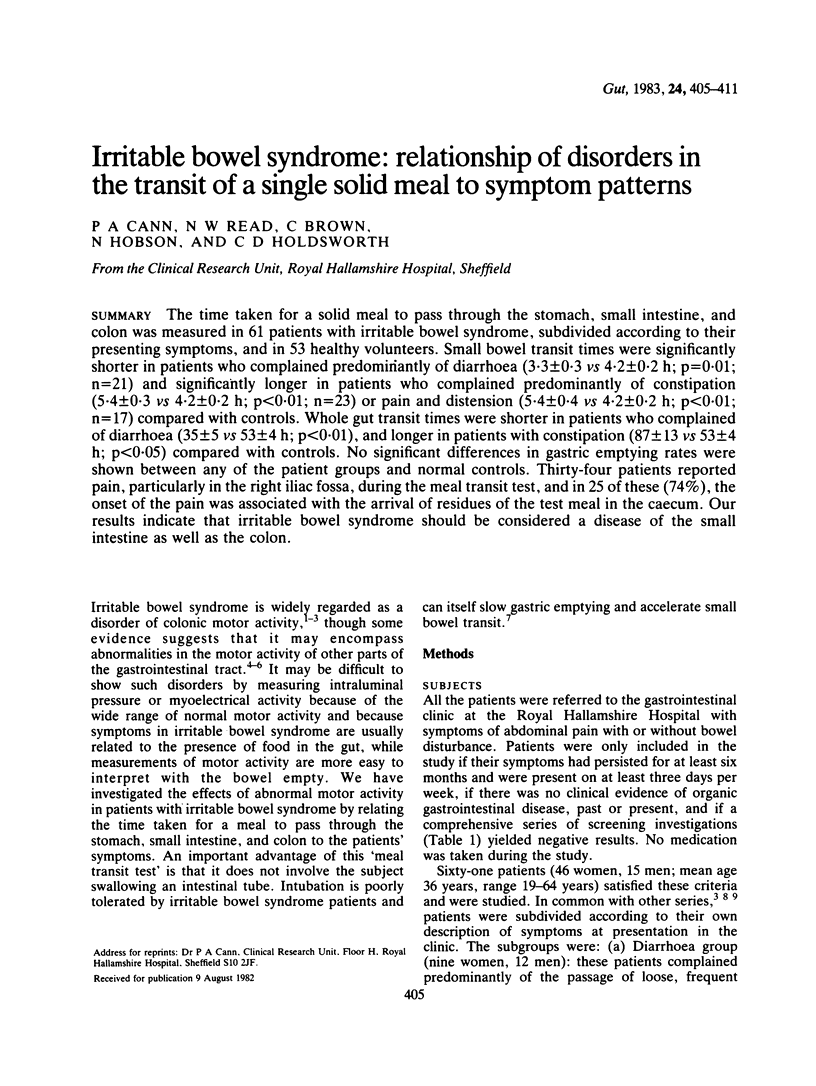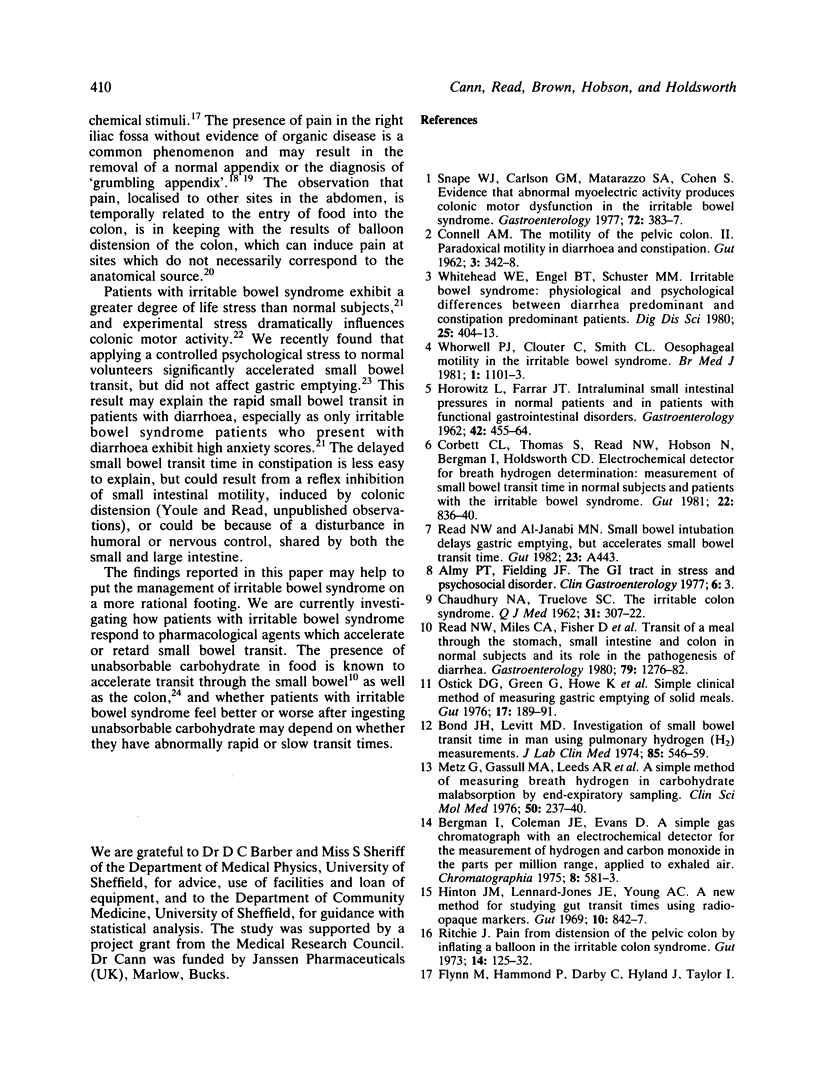Abstract
The time taken for a solid meal to pass through the stomach, small intestine, and colon was measured in 61 patients with irritable bowel syndrome, subdivided according to their presenting symptoms, and in 53 healthy volunteers. Small bowel transit times were significantly shorter in patients who complained predominantly of diarrhoea (3.3 +/- 0.3 vs 4.2 +/- 0.2 h; p = 0.01; n = 21) and significantly longer in patients who complained predominantly of constipation (5.4 +/- 0.3 vs 4.2 +/- 0.2 h; p less than 0.01; n = 23) or pain and distension (5.4 +/- 0.4 vs 4.2 +/- 0.2 h; p less than 0.01; n = 17) compared with controls. Whole gut transit times were shorter in patients who complained of diarrhoea (35 +/- 5 vs 53 +/- 4 h; p less than 0.01), and longer in patients with constipation (87 +/- 13 vs 53 +/- 4 h; p less than 0.05) compared with controls. No significant differences in gastric emptying rates were shown between any of the patient groups and normal controls. Thirty-four patients reported pain, particularly in the right iliac fossa, during the meal transit test, and in 25 of these (74%), the onset of the pain was associated with the arrival of residues of the test meal in the caecum. Our results indicate that irritable bowel syndrome should be considered a disease of the small intestine as well as the colon.
Full text
PDF






Selected References
These references are in PubMed. This may not be the complete list of references from this article.
- Bond J. H., Jr, Levitt M. D., Prentiss R. Investigation of small bowel transit time in man utilizing pulmonary hydrogen (H2) measurements. J Lab Clin Med. 1975 Apr;85(4):546–555. [PubMed] [Google Scholar]
- CHAUDHARY N. A., TRUELOVE S. C. The irritable colon syndrome. A study of the clinical features, predisposing causes, and prognosis in 130 cases. Q J Med. 1962 Jul;31:307–322. [PubMed] [Google Scholar]
- CONNELL A. M. The motility of the pelvic colon. II. Paradoxical motility in diarrhoea and constipation. Gut. 1962 Dec;3:342–348. doi: 10.1136/gut.3.4.342. [DOI] [PMC free article] [PubMed] [Google Scholar]
- Cann P. A., Read N. W., Cammack J., Childs H., Holden S., Kashman R., Longmore J., Nix S., Simms N., Swallow K. Psychological stress and the passage of a standard meal through the stomach and small intestine in man. Gut. 1983 Mar;24(3):236–240. doi: 10.1136/gut.24.3.236. [DOI] [PMC free article] [PubMed] [Google Scholar]
- Corbett C. L., Thomas S., Read N. W., Hobson N., Bergman I., Holdsworth C. D. Electrochemical detector for breath hydrogen determination: measurement of small bowel transit time in normal subjects and patients with the irritable bowel syndrome. Gut. 1981 Oct;22(10):836–840. doi: 10.1136/gut.22.10.836. [DOI] [PMC free article] [PubMed] [Google Scholar]
- Creed F. Life events and appendicectomy. Lancet. 1981 Jun 27;1(8235):1381–1385. doi: 10.1016/s0140-6736(81)92567-8. [DOI] [PubMed] [Google Scholar]
- Esler M. D., Goulston K. J. Levels of anxiety in colonic disorders. N Engl J Med. 1973 Jan 4;288(1):16–20. doi: 10.1056/NEJM197301042880104. [DOI] [PubMed] [Google Scholar]
- Flynn M., Hammond P., Darby C., Hyland J., Taylor I. Faecal bile acids and the irritable colon syndrome. Digestion. 1981;22(3):144–149. doi: 10.1159/000198624. [DOI] [PubMed] [Google Scholar]
- HOROWITZ L., FARRAR J. T. Intraluminal small intestinal pressures in normal patients and in patients with functional gastrointestinal disorders. Gastroenterology. 1962 Apr;42:455–464. [PubMed] [Google Scholar]
- Harvey R. F., Pomare E. W., Heaton K. W. Effects of increased dietary fibre on intestinal transit. Lancet. 1973 Jun 9;1(7815):1278–1280. doi: 10.1016/s0140-6736(73)91294-4. [DOI] [PubMed] [Google Scholar]
- Hinton J. M., Lennard-Jones J. E., Young A. C. A ne method for studying gut transit times using radioopaque markers. Gut. 1969 Oct;10(10):842–847. doi: 10.1136/gut.10.10.842. [DOI] [PMC free article] [PubMed] [Google Scholar]
- ING, OPPENHEIMANRAM P. W., EVANS G. RIGHT ILIAC FOSSA PAIN IN YOUNG WOMEN; WITH APPENDIX ON THE CORNELL MEDICAL INDEX HEALTH QUESTIONNAIRE. Br Med J. 1965 Jul 17;2(5454):149–151. doi: 10.1136/bmj.2.5454.149. [DOI] [PMC free article] [PubMed] [Google Scholar]
- Metz G., Gassull M. A., Leeds A. R., Blendis L. M., Jenkins D. J. A simple method of measuring breath hydrogen in carbohydrate malabsorption by end-expiratory sampling. Clin Sci Mol Med. 1976 Mar;50(3):237–240. doi: 10.1042/cs0500237. [DOI] [PubMed] [Google Scholar]
- Ostick D. G., Howe K., Green G., Dymock I. W., Cowley D. J. Simple clinical method of measuring gastric emptying of solid meals. Gut. 1976 Mar;17(3):189–191. doi: 10.1136/gut.17.3.189. [DOI] [PMC free article] [PubMed] [Google Scholar]
- Read N. W., Miles C. A., Fisher D., Holgate A. M., Kime N. D., Mitchell M. A., Reeve A. M., Roche T. B., Walker M. Transit of a meal through the stomach, small intestine, and colon in normal subjects and its role in the pathogenesis of diarrhea. Gastroenterology. 1980 Dec;79(6):1276–1282. [PubMed] [Google Scholar]
- Ritchie J. Pain from distension of the pelvic colon by inflating a balloon in the irritable colon syndrome. Gut. 1973 Feb;14(2):125–132. doi: 10.1136/gut.14.2.125. [DOI] [PMC free article] [PubMed] [Google Scholar]
- Snape W. J., Jr, Carlson G. M., Matarazzo S. A., Cohen S. Evidence that abnormal myoelectrical activity produces colonic motor dysfunction in the irritable bowel syndrome. Gastroenterology. 1977 Mar;72(3):383–387. [PubMed] [Google Scholar]
- Swarbrick E. T., Hegarty J. E., Bat L., Williams C. B., Dawson A. M. Site of pain from the irritable bowel. Lancet. 1980 Aug 30;2(8192):443–446. doi: 10.1016/s0140-6736(80)91885-1. [DOI] [PubMed] [Google Scholar]
- Whitehead W. E., Engel B. T., Schuster M. M. Irritable bowel syndrome: physiological and psychological differences between diarrhea-predominant and constipation-predominant patients. Dig Dis Sci. 1980 Jun;25(6):404–413. doi: 10.1007/BF01395503. [DOI] [PubMed] [Google Scholar]
- Whorwell P. J., Clouter C., Smith C. L. Oesophageal motility in the irritable bowel syndrome. Br Med J (Clin Res Ed) 1981 Apr 4;282(6270):1101–1102. doi: 10.1136/bmj.282.6270.1101. [DOI] [PMC free article] [PubMed] [Google Scholar]


